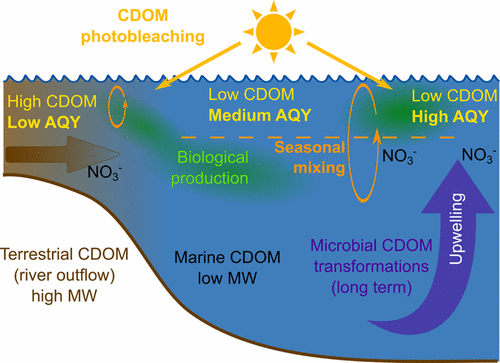Photolysis is a major removal pathway for the biogenic gas dimethylsulfide (DMS) in the surface ocean. Here we tested the hypothesis that apparent quantum yields (AQY) for DMS photolysis varied according to the quantity and quality of its photosensitizers, chiefly chromophoric dissolved organic matter (CDOM) and nitrate. AQY compiled from the literature and unpublished studies ranged across 3 orders of magnitude at the 330 nm reference wavelength. The smallest AQY(330) were observed in coastal waters receiving major riverine inputs of terrestrial CDOM (0.06–0.5 m3 (mol quanta)−1). In open-ocean waters, AQY(330) generally ranged between 1 and 10 m3 (mol quanta)−1. The largest AQY(330), up to 34 m3 (mol quanta)−1), were seen in the Southern Ocean potentially associated with upwelling. Despite the large AQY variability, daily photolysis rate constants at the sea surface spanned a smaller range (0.04–3.7 d–1), mainly because of the inverse relationship between CDOM absorption and AQY. Comparison of AQY(330) with CDOM spectral signatures suggests there is an interplay between CDOM origin (terrestrial versus marine) and photobleaching that controls variations in AQYs, with a secondary role for nitrate. Our results can be used for regional or large-scale assessment of DMS photolysis rates in future studies.
